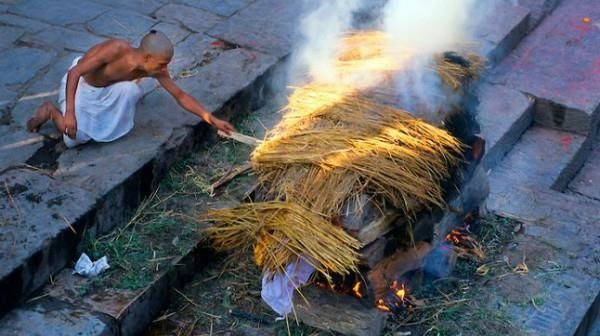In the heart of Hindu funerary rites lies a practice both solemn and symbolic: Kapalkriya. The act of piercing or breaking the skull of the deceased during cremation underscores a profound spiritual significance within the vast tapestry of Hindu beliefs in death, the soul, and the afterlife. Understanding Kapalkriya requires delving into its purpose, symbolism, and the philosophical framework that gives it meaning.
The Practical Aspect of Kapalkriya
On a practical level, Kapalkriya serves a functional purpose within the cremation process. The human skull is a dense structure designed to protect the brain. During cremation, the intense heat causes fluids and gases inside the skull to build up pressure. If this pressure is not released, it can lead to the skull bursting in a potentially disturbing or hazardous manner. The act of Kapalkriya creates an outlet, allowing for a smoother and more controlled cremation.
The Journey of the Atman
However, the true significance of Kapalkriya transcends the practical. At the heart lies a deep spiritual symbolism connected to the Hindu concept of the Atman – the individual soul or the true self. According to Hindu philosophy, death is not the end of existence; it’s a transition of the Atman from the physical body to continue its journey in the cycle of reincarnation. Hindus believe that the Atman resides within the skull during life. Kapalkriya is seen as a way to facilitate the soul’s release from its earthly vessel and assist its passage to the next stage of its journey.
Who performs Kapalkriya?
Traditionally, the responsibility of performing Kapalkriya falls on the eldest son, symbolizing the continuation of the lineage. However, in cases where the eldest son is unavailable or unable to perform the act, a close male relative such as a husband, brother, or nephew can be entrusted with the task. This individual acts as the chief mourner and is considered responsible for ensuring the proper and respectful completion of the cremation rituals.
The Ritual in Action
The specific manner of performing Kapalkriya may vary slightly depending on regional customs and individual family preferences. However, the core elements are usually as follows:
- Preparation: Following the placement of the deceased on the funeral pyre, the designated individual typically picks up a bamboo stave or a similar object sanctified through fire rituals.
- The Act: The individual then approaches the head of the deceased and carefully touches, pierces, or cracks the skull with the implement. Some traditions might also involve pouring consecrated water or ghee (clarified butter) into the opening created.
- Completion: After performing the act, the individual completes the ritual by offering prayers or mantras for the peaceful journey of the Atman.
Symbolism and Tradition
Several interpretations and layers of symbolism are associated with Kapalkriya:
- Destruction of Ego: The skull represents the seat of the material mind and the ego. Its ceremonial “breaking” signifies the detachment from the ego and the destruction of worldly attachments.
- Liberation of the Soul: The opening made in the skull is seen as a doorway for the Atman to escape the confines of the physical body and embark on its spiritual journey.
- Merging with the Divine: Kapalkriya embodies a longing for the Atman to dissolve into the ultimate reality, to be reabsorbed into the universal consciousness or merge with the divine.
Evolution and Varying Practices
While Kapalkriya is deeply rooted in tradition, the practice has evolved with time. In some communities, the ritual may involve pouring consecrated water or ghee (clarified butter) into the hole created in the skull. In others, the practice may be purely symbolic, with the implement simply touching the skull. Some families may prefer to forgo the practice altogether, opting for modern cremation techniques.
Controversy and Respect
Kapalkriya, due to its graphic nature, may occasionally be a source of misunderstanding or controversy. It’s essential to remember that the practice is deeply embedded within a belief system that views death and afterlife in a light vastly different from many Western perspectives. Sensitivity and respect towards Hindu customs and traditions are of utmost importance when discussing or witnessing rituals like Kapalkriya.
The Essence of Kapalkriya
Beyond its practical and sensational elements, Kapalkriya epitomizes the profound Hindu philosophy surrounding death and the Atman’s continuous journey. It’s a powerful reminder of death’s inevitability, a facilitator of release and spiritual transition, and a symbolic expression of life’s impermanence.






